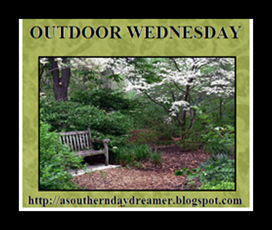A cold winter with deep snow like we're having provides a perfect time to explore wetlands, where you can snowshoe into places you could never reach at other seasons. The botany isn't as interesting of course, but it's still interesting to get into the heart of a wetland and see what it's like.
This wetland, an open water marsh with a lot of dead cedars, is on a Bruce Trail property. The standing dead cedars were killed years ago by the dam that created the wetland, raising the water level here. I knew that others had been in the day before, but I couldn't accompany them because of a meeting, so the day being perfect, I followed their snowshoe tracks in to explore it.
Their purpose in snowshoeing in was to check on the wood duck nesting boxes. There are three of these in the wetland, put there by Ducks Unlimited, and they need to be checked and cleaned out each year. This is the easiest time of year to do it. They did find remnants of duck nests in the boxes this year.
The boxes are on high steel poles, but the upper part of the pole can be lifted out to get access to the nesting box. It was hard to imagine a more beautiful winter day; the sky was a really deep blue and almost cloudless.
Wood ducks nest in cavities in trees if available, but there have been widespread efforts to provide nesting boxes to support them. They actually have claws that allow them to perch in trees, unlike most ducks, and they prefer wooded swamps or marshes with some standing trees - like this one. The young jump out of the nest the day after hatching, and are able to swim and find food for themselves right away - what an introduction to life!
This wetland is created by a dam a few hundred yards downstream, and down in the deeper part of the wetland there are a lot of fallen trees, and some patches of open flowing water. This was off limits for snowshoeing as far as I was concerned!
But thanks to the snowshoes I had a very interesting visit to the wetland, exploring an area I will never otherwise see. I liked the pattern of this photo, with the dead trees and last year's bulrushes sticking up through the snow.
Just for interest, here's a corner of the wetland, with one of the wood duck boxes visible through the trees on the right, taken back in November. This was as close as I could get with the open water. Quite a big seasonal difference!
Linking to:



















































